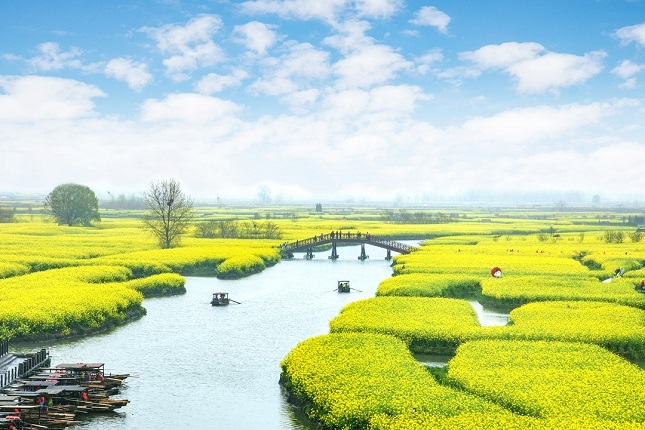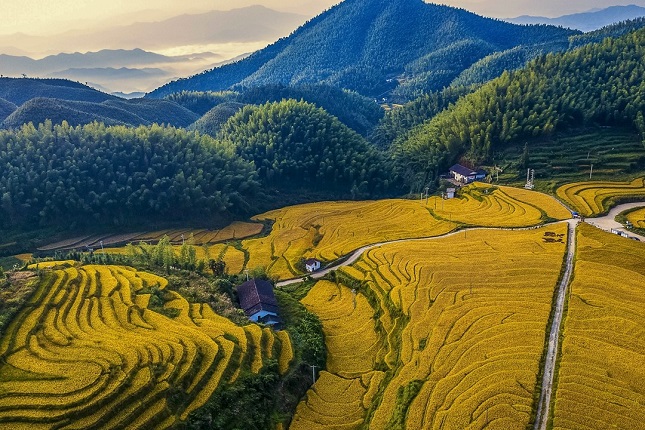Editor's Note
Four Chinese historical irrigation sites were recognized as World Heritage Irrigation Structures, the International Commission on Irrigation and Drainage announced in Adelaide, Australia, on October 6. This brings the total number of such sites in China to 30, more than one fifth of the world's 140 sites. The four sites - the Tongjiyan Irrigation System, Xinghua Duotian Irrigation and Drainage System, Songgu Irrigation Scheme and Chongyi Shangbao Terraces - show that China has "the richest types, widest distribution and highest irrigation efficiency in heritage structures."
In this two-part series, the Global Times will provide detailed introductions to the four sites alongside explanations from experts, so that readers may better understand the wisdom of China and how the ancients practiced the concept of "man as an integral part of nature" to achieve balanced agricultural and ecological development.
Four more ancient Chinese irrigation sites have been recognized as World Heritage Irrigation Structures. While these structures are renowned for their age, with some of them dating back to more than 2,000 years ago, their ability to prevent natural disasters such as floods and droughts by working with nature instead of against it is even more important for an era that places increasing emphasis on green living.
Besides the Tongjiyan Irrigation System and Songgu Irrigation Scheme introduced in part one of this series, the Xinghua Duotian Irrigation and Drainage System and Chongyi Shangbao Terraces are also historic products of human beings living in harmony with the natural environment and also outstanding models of "water culture."
Working with nature
The Xinghua Duotian Irrigation and Drainage System, located in Xinghua, East China's Jiangsu Province, provides water to arid highlands through the use of dikes, channels and sluice gates. First built during the Tang Dynasty (618-907), it continues to contribute to local irrigation and drainage, flood control, green agriculture and tourism to this day.
The system is a world-level wonder for its unique water-land utilization method that creates splendid raised fields known as duotian (Lit: pile fields). Built in wetland areas, these duotian fields end up looking like small islets drifting on the sea.
To avoid flood damage to crops, over the past millennia, the people of Xinghua have built wooden structures upon which they placed small stacks of mud to form these duotian, turning wild wetlands into cultivable land. The duotian is a perfect model for making the most of natural conditions while living in harmony with nature.
The Chongyi Shangbao Terraces cover an area of about 3,400 hectares in the mountainous region of Chongyi county in East China's Jiangxi Province. First built on steep slopes during the Song Dynasty (960-1279) and later perfected during the Ming (1368-1644) and Qing (1644-1911) dynasties, the terraces make use of innovative irrigation and ecological systems that help prevent flooding and droughts.
Instead of attempting to flatten the hilly area, farmers created these terrace fields according to the natural terrain, making use of gravity irrigation to produce fields that yield around 500 kilograms of rice per 600 square meters.
Zhou Xueying, a Chinese historian, told the Global Times that behind the Chinese irrigation system, there is a touch of "romance" that can contribute to the scientific-oriented agriculture research from the West.
"The irrigation system is human being's compromise with nature. Harnessing nature by following the natural order demonstrates the Chinese belief in 'harmony.' This is a rather euphemistic approach which is unique to Asian culture," Zhou noted.

People pilot boats among the raised fields of the Xinghua Duotian Irrigation and Drainage System in East China's Jiangsu Province. Photo: VCG
Role models for today
Even though these ancient irrigation systems were built centuries ago, they offer useful principles for utilizing water sources and benefiting farming from which today's agricultural industry can learn.
"Some designs and concepts from ancient irrigation systems and water conservation projects still play a major role when we build similar projects nowadays, such as the sluice technology from an ancient water reservoir by the Haihe River in Tianjin Municipality - the sluice gates used there are one of the most common hydraulic structures used in rivers and canals to control water levels. And that's not mentioning the Dujiangyan irrigation system in Sichuan Province that has been used for almost 2,000 years," historical geographer and Fudan University professor Li Xiaojie told the Global Times.
Since summer, many farms along the Yangtze River, including some in Sichuan and Jiangxi provinces, have been suffering from drought. To combat the losses of farmland and guarantee water supplies for local residents, the Chinese government has carried out diverse water control measures, many of which have drawn upon the ancient wisdom seen in traditional irrigation systems such as the Dujiangyan Irrigation System.
Main photo: The Chongyi Shangbao Terraces in East China's Jiangxi Province © VCG.
Source: The Global Times.
































